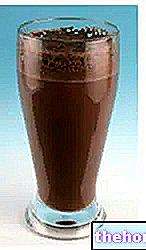Edited by Dr. Davide Racaniello
Generality
Conjugated linoleic acid, more simply called CLA, is an isomer of the better known linoleic acid (LA).
Linoleic acid is a polyunsaturated fatty acid belonging to the omega 6 family, characterized by a carbonaceous skeleton of 18 atoms and by two double bonds, the first of which in position 6 (see figure).


The particular chemical structure of this fatty acid defines sixteen possible isomers, but mainly two are found in nature, 9 cis - 11 trans and 10 cis - 12 trans, whose abundance is certainly correlated to its biological functionality.

These enzymes, on the other hand, belong to the rumen (stomach with digestive functions) of ruminants, where the presence of specific microorganisms is able to induce the incomplete biohydrogenation reaction necessary for its synthesis.
It can therefore be easily deduced that one of the main sources of this substance is animal meat, but above all milk and its derivatives.
However, there are other sources of CLA, such as safflower and sunflower oil, from which it is preferred to extract to produce specific supplements.
In a healthy diet, the amount of conjugated linoleic acid introduced daily with the diet was estimated to be between 20 and 170 mg, a much lower quantity than that suggested by the various supplementary protocols.
Indications
Why is CLA used? What is it for?
Different biological functions are classically attributed to CLA, mostly observed on experimental models.
More precisely, from the first indications, in addition to the nutritional role, potential activities would emerge:
- anticancer;
- antithrombotic;
- immunomodulatory;
- antiobesigene;
- antidiabetic.
However, despite the huge number of published articles, most of the documentation has been obtained on in vitro or animal models, making the interpretation of the effects of a specific CLA supplementation in humans somewhat problematic.
To this limit are added others, deriving from the pro-inflammatory role of some isomers of this fatty acid.
Properties and Effectiveness
What benefits has CLA shown during the studies?
As mentioned, most of the studies currently available in the literature describe the biological effects of CLA on experimental models.
Valuable functions but also noteworthy limitations would emerge from these studies.
CLA and cancer
The anticarcinogenic action seems to be carried out through the modulation of the apoptotic signal, both on in vitro and animal models. This activity has been observed against neoplastic pathologies of the breast, lung and intestine.
To date, there is a lack of significant clinical trials that show this ability also on humans.
CLA and cardiovascular health
The antithrombotic action seems to be guaranteed by the ability of CLA to modulate the synthesis of arachidonic acid and pro-inflammatory molecules, such as thromboxanes, leukotrienes and some prostaglandins.
Thanks to this activity, CLA would present an important protective action against the cardiovascular system.
CLA and immunity
The immunomodulatory action of CLA, also active on healthy individuals, would facilitate the reduction of the concentrations of immunoglobulins responsible for allergic reactions (IgE), while increasing the effectiveness of the specific immune response.
This would result, on the one hand, in a lower risk of autoimmune reactions, and on the other in a more effective protection against potential pathogens.
CLA and body composition
CLA has earned an important place in sports dietetics, due to its potential improving role in relation to body composition.
Going into more detail, an "important partitioning action would be observed, responsible for a significant decrease in the levels of fat mass in favor of muscle mass.
This action, particularly evident on animal models, where the dosages used far exceed those applicable to humans - is drastically reduced in humans, where weight loss induced by supplementation with CLA would be around 90 g / week.

Limitations of integration with CLA
Despite the potential effects of conjugated linoleic acid, the scientific literature and leading world experts still seem skeptical in suggesting its use as a food supplement.
This widespread perplexity arises both from the observation of experimental data, with a significant reduction in efficacy passing from the laboratory animal to man, and from the presence of studies that warn of potential but important side effects:
- Increase of inflammatory biomarkers (c-reactive protein and white blood cells), potentially dangerous for some types of pathologies;
- Increased Insulin Resistance: This effect, which appears to be more pronounced for the T10, C12 isomer, drops significantly when using an equally composed mixture.
- Increased oxidative stress: increase in lipoperoxidation levels.
- Dyslipidemic effect: associated with the T10 isomer, C12, it results in a reduction in plasma HDL cholesterol levels, with an increase in LDL and an increase in hepatic lipid concentration.
Consequentially,
- The presence of these evidences, even if mainly attributable to one of the two isomers present in nature;
- The absence of standardized and controlled extraction protocols that can reassure the user about the correct racemic composition between the two isomers;
- The absence of benefits so important as to justify some risk
definitely limit the spread of CLA among food supplements.
Dosage and method of use
How to use the CLA
The dosage proposed by the various studies in the literature provides for a series of values between 2 grams and 6.4 grams of CLA per day, even if the most replicated one, and which seems to give better results, is around 3.4. grams.
Generally the maximum intake of 0.1 g / kg per day should not be exceeded.
Given the chemical structure, it would be preferable to take CLA during meals, in order to improve its absorption, dividing the total daily portion into at least 3 intakes, compatibly with the dosages proposed by the various manufacturers.
Side effects
The use of CLA is generally safe and well tolerated, although gastrointestinal reactions such as nausea and abdominal pain may occur at doses greater than 2 grams per day.
Contraindications
When CLA is not to be used
The use of CLA is contraindicated in cases of renal or hepatic pathology, cardiovascular disease and / or hypertension, and in case of hypersensitivity to the active ingredient.
Pharmacological interactions
What drugs or foods can change the effect of CLA?
No noteworthy drug interactions are currently known between CLA and other active ingredients.
Precautions for use
What do you need to know before taking CLA?
Given the lack of studies on this, the use of CLA should be avoided during pregnancy and in the subsequent breastfeeding period.
In case of prolonged use (over 6/8 weeks) it would be necessary to seek the advice of the doctor.




























